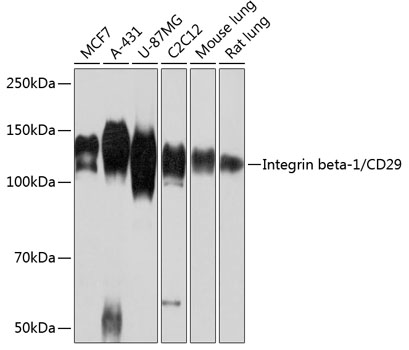Cell Biology Antibodies 17
Anti-Integrin beta-1/CD29 Antibody (CAB19072)
- SKU:
- CAB19072
- Product Type:
- Antibody
- Reactivity:
- Human
- Reactivity:
- Mouse
- Reactivity:
- Rat
- Host Species:
- Rabbit
- Isotype:
- IgG
- Research Area:
- Cell Biology
Description
| Antibody Name: | Anti-Integrin beta-1/CD29 Antibody |
| Antibody SKU: | CAB19072 |
| Antibody Size: | 20uL, 50uL, 100uL |
| Application: | WB |
| Reactivity: | Human, Mouse, Rat |
| Host Species: | Rabbit |
| Immunogen: | A synthesized peptide derived from human Integrin beta 1 |
| Application: | WB |
| Recommended Dilution: | WB 1:500 - 1:2000 |
| Reactivity: | Human, Mouse, Rat |
| Positive Samples: | MCF7, A-431, U-87MG, C2C12, Mouse lung, Rat lung |
| Immunogen: | A synthesized peptide derived from human Integrin beta 1 |
| Purification Method: | Affinity purification |
| Storage Buffer: | Store at -20°C. Avoid freeze / thaw cycles. Buffer: PBS with 0.02% sodium azide, 0.05% BSA, 50% glycerol, pH7.3. |
| Isotype: | IgG |
| Sequence: | Email for sequence |
| Gene ID: | 3688 |
| Uniprot: | P05556 |
| Cellular Location: | |
| Calculated MW: | 150kDa |
| Observed MW: | 135kDa |
| Synonyms: | CD29, FNRB, GPIIA, MDF2, MSK12, VLA-BETA, VLAB, Integrin beta 1, ITGB1, Integrin Beta1 |
| Background: | Integrins are heterodimeric proteins made up of alpha and beta subunits. At least 18 alpha and 8 beta subunits have been described in mammals. Integrin family members are membrane receptors involved in cell adhesion and recognition in a variety of processes including embryogenesis, hemostasis, tissue repair, immune response and metastatic diffusion of tumor cells. This gene encodes a beta subunit. Multiple alternatively spliced transcript variants which encode different protein isoforms have been found for this gene. [provided by RefSeq, Jul 2008] |
| UniProt Protein Function: | ITGB1: an integral membrane protein that heterodimerizes with an alpha-3 chain, forming a receptor for many extracellular-matrix proteins including fibronectin, laminin, collagen, epiligrin and thrombospondin.. Beta 1 integrins recognize the amino-acid motif RGD in a wide array of ligands. Five alternatively spliced variants with alternate carboxy termini have been described. Two alternatively spliced isoforms have been described. Isoform beta-1a is widely expressed; other isoforms are generally expressed with a more restricted distribution. Isoform beta-1b is expressed in skin, liver, skeletal muscle, cardiac muscle, placenta, umbilical vein endothelial cells, neuroblastoma cells, lymphoma cells, hepatoma cells and astrocytoma cells. Isoforms beta-1c and beta-1c-2 are expressed in muscle, kidney, liver, placenta, cervical epithelium, umbilical vein endothelial cells, fibroblast cells, embryonal kidney cells, platelets and several blood cell lines. Isoform beta-c-2, rather than isoform beta-1c, is selectively expressed in primary t-cells. Isoform beta-1c is expressed in nonproliferating and differentiated prostate gland epithelial cells. Isoform beta-1d is expressed specifically in striated muscle (skeletal and cardiac muscle). |
| UniProt Protein Details: | Protein type:Cell adhesion; Cell surface; Membrane protein, integral; Motility/polarity/chemotaxis; Receptor, misc. Chromosomal Location of Human Ortholog: 10p11.22 Cellular Component: cell surface; cell-cell adherens junction; cytoplasm; filopodium; focal adhesion; lipid raft; membrane; neuromuscular junction; plasma membrane; receptor complex; ruffle; sarcolemma Molecular Function:actin binding; C-X3-C chemokine binding; cell adhesion molecule binding; coreceptor activity; fibronectin binding; protease binding; protein binding; protein complex binding; protein heterodimerization activity Biological Process: B cell differentiation; calcium-independent cell-matrix adhesion; cell adhesion mediated by integrin; cell migration; cell-cell adhesion mediated by integrin; cell-matrix adhesion; cell-substrate adhesion; cellular defense response; extracellular matrix organization and biogenesis; heterotypic cell-cell adhesion; homophilic cell adhesion; integrin-mediated signaling pathway; leukocyte adhesion; leukocyte migration; leukocyte tethering or rolling; mesodermal cell differentiation; positive regulation of apoptosis; positive regulation of GTPase activity; receptor internalization; regulation of immune response; stress fiber formation; transforming growth factor beta receptor signaling pathway |
| NCBI Summary: | Integrins are heterodimeric proteins made up of alpha and beta subunits. At least 18 alpha and 8 beta subunits have been described in mammals. Integrin family members are membrane receptors involved in cell adhesion and recognition in a variety of processes including embryogenesis, hemostasis, tissue repair, immune response and metastatic diffusion of tumor cells. This gene encodes a beta subunit. Multiple alternatively spliced transcript variants which encode different protein isoforms have been found for this gene. [provided by RefSeq, Jul 2008] |
| UniProt Code: | P05556 |
| NCBI GenInfo Identifier: | 218563324 |
| NCBI Gene ID: | 3688 |
| NCBI Accession: | P05556.2 |
| UniProt Secondary Accession: | P05556,P78466, P78467, Q13089, Q13090, Q13091, Q13212 A8K6N2, D3DRX9, D3DRY3, D3DRY4, D3DRY5, |
| UniProt Related Accession: | P05556 |
| Molecular Weight: | 88,884 Da |
| NCBI Full Name: | Integrin beta-1 |
| NCBI Synonym Full Names: | integrin subunit beta 1 |
| NCBI Official Symbol: | ITGB1 |
| NCBI Official Synonym Symbols: | CD29; FNRB; MDF2; VLAB; GPIIA; MSK12; VLA-BETA |
| NCBI Protein Information: | integrin beta-1 |
| UniProt Protein Name: | Integrin beta-1 |
| UniProt Synonym Protein Names: | Fibronectin receptor subunit beta; Glycoprotein IIa; GPIIA; VLA-4 subunit beta; CD_antigen: CD29 |
| UniProt Gene Name: | ITGB1 |







